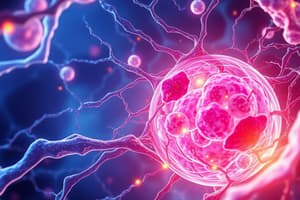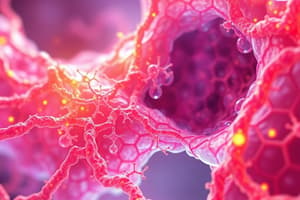Podcast
Questions and Answers
Which type of fiber is NOT typically associated with connective tissue?
Which type of fiber is NOT typically associated with connective tissue?
- Collagen fibers
- Elastic fibers
- Reticular fibers
- Myelin fibers (correct)
Which cell type in connective tissue is primarily responsible for the production and maintenance of fibers?
Which cell type in connective tissue is primarily responsible for the production and maintenance of fibers?
- Fibroblasts (correct)
- Adipose cells
- Mast cells
- Plasma cells
What is the primary composition of ground substance in connective tissue?
What is the primary composition of ground substance in connective tissue?
- Proteins and collagen only
- Water, carbohydrates, and lipids
- Fibers and enzymes
- Water, carbohydrates, and proteins (correct)
Which statement best describes the properties of collagen fibers?
Which statement best describes the properties of collagen fibers?
Where could you expect to find reticular fibers in the body?
Where could you expect to find reticular fibers in the body?
Which type of connective tissue primarily contains a significant number of fibroblast cells?
Which type of connective tissue primarily contains a significant number of fibroblast cells?
What feature distinguishes regular dense connective tissue from irregular dense connective tissue?
What feature distinguishes regular dense connective tissue from irregular dense connective tissue?
What happens to fat cells when adipose tissue is stained with haematoxylin and eosin?
What happens to fat cells when adipose tissue is stained with haematoxylin and eosin?
Which type of connective tissue is characterized by a fine meshwork of collagen fibers and abundant ground substance?
Which type of connective tissue is characterized by a fine meshwork of collagen fibers and abundant ground substance?
Which type of connective tissue would you expect to find predominately in structures like the spleen and lymph nodes?
Which type of connective tissue would you expect to find predominately in structures like the spleen and lymph nodes?
What is the primary function of cartilage in the human body?
What is the primary function of cartilage in the human body?
Which type of connective tissue arrangement is typically found in the dermis of the skin?
Which type of connective tissue arrangement is typically found in the dermis of the skin?
What is the main component that makes bone the hardest form of connective tissue?
What is the main component that makes bone the hardest form of connective tissue?
Which type of cartilage is characterized by a matrix containing branching elastic fibers?
Which type of cartilage is characterized by a matrix containing branching elastic fibers?
What type of bones mainly make up the axial skeleton?
What type of bones mainly make up the axial skeleton?
Which type of bone does NOT have a perichondrium?
Which type of bone does NOT have a perichondrium?
What function do sesamoid bones primarily serve?
What function do sesamoid bones primarily serve?
Which of the following is an example of long bones?
Which of the following is an example of long bones?
What term describes bones like the clavicle that develop from mesenchymal tissue?
What term describes bones like the clavicle that develop from mesenchymal tissue?
Which type of cartilage has chondrocytes appearing singly and arranged in rows between bundles of collagen fibers?
Which type of cartilage has chondrocytes appearing singly and arranged in rows between bundles of collagen fibers?
What is the primary function of bones in terms of weight?
What is the primary function of bones in terms of weight?
What is the main function of the perichondrium in cartilage?
What is the main function of the perichondrium in cartilage?
Which of the following best describes the composition of the matrix in cartilage?
Which of the following best describes the composition of the matrix in cartilage?
Which type of cartilage is characterized by a covering of perichondrium and has a homogeneous matrix with no distinct collagen fibers visible?
Which type of cartilage is characterized by a covering of perichondrium and has a homogeneous matrix with no distinct collagen fibers visible?
What distinguishes the territorial matrix from the interterritorial matrix in hyaline cartilage?
What distinguishes the territorial matrix from the interterritorial matrix in hyaline cartilage?
Which cells are primarily responsible for producing the matrix in cartilage?
Which cells are primarily responsible for producing the matrix in cartilage?
Which type of cartilage allows for a significant degree of elasticity, returning to its original shape after deformation?
Which type of cartilage allows for a significant degree of elasticity, returning to its original shape after deformation?
What type of fibers are predominantly found in fibrocartilage?
What type of fibers are predominantly found in fibrocartilage?
In the cellular structure of cartilage, which cells are considered immature and found in the perichondrium?
In the cellular structure of cartilage, which cells are considered immature and found in the perichondrium?
Which statement regarding the nature of hyaline cartilage is incorrect?
Which statement regarding the nature of hyaline cartilage is incorrect?
Flashcards
Fibroblasts in connective tissue
Fibroblasts in connective tissue
Most common cells in animal connective tissue, responsible for producing and maintaining the fibers and ground substance.
Adipocytes (Fat cells)
Adipocytes (Fat cells)
Specialized cells for storing fat; have a large lipid droplet and a flattened nucleus.
Collagen fibers
Collagen fibers
Strong, inelastic fibers found in most connective tissues, providing tensile strength.
Elastic fibers
Elastic fibers
Signup and view all the flashcards
Ground substance of connective tissue
Ground substance of connective tissue
Signup and view all the flashcards
Superficial Fascia
Superficial Fascia
Signup and view all the flashcards
Adipose Tissue
Adipose Tissue
Signup and view all the flashcards
What makes fat cells appear empty when stained?
What makes fat cells appear empty when stained?
Signup and view all the flashcards
Myxomatous Tissue
Myxomatous Tissue
Signup and view all the flashcards
Reticular Tissue
Reticular Tissue
Signup and view all the flashcards
Regular Dense Connective Tissue
Regular Dense Connective Tissue
Signup and view all the flashcards
Irregular Dense Connective Tissue
Irregular Dense Connective Tissue
Signup and view all the flashcards
What is cartilage?
What is cartilage?
Signup and view all the flashcards
What are chondrocytes?
What are chondrocytes?
Signup and view all the flashcards
What is perichondrium?
What is perichondrium?
Signup and view all the flashcards
What are chondroblasts?
What are chondroblasts?
Signup and view all the flashcards
What are the components of cartilage matrix?
What are the components of cartilage matrix?
Signup and view all the flashcards
What is ground substance?
What is ground substance?
Signup and view all the flashcards
What are the types of fibers in cartilage?
What are the types of fibers in cartilage?
Signup and view all the flashcards
What are the types of cartilage?
What are the types of cartilage?
Signup and view all the flashcards
What is hyaline cartilage?
What is hyaline cartilage?
Signup and view all the flashcards
Auricle of Ear
Auricle of Ear
Signup and view all the flashcards
Epiglottis
Epiglottis
Signup and view all the flashcards
Perichondrium
Perichondrium
Signup and view all the flashcards
Chondrocytes
Chondrocytes
Signup and view all the flashcards
Fibrocartilage
Fibrocartilage
Signup and view all the flashcards
What's the difference between hyaline and elastic cartilage?
What's the difference between hyaline and elastic cartilage?
Signup and view all the flashcards
Bone Matrix
Bone Matrix
Signup and view all the flashcards
Erythropoiesis
Erythropoiesis
Signup and view all the flashcards
What are the major functions of bones?
What are the major functions of bones?
Signup and view all the flashcards
Study Notes
Connective Tissue Overview
- Connective tissue: One of the basic tissues in the body. It connects and supports various tissues.
- Origin: Develops from mesoderm or mesenchyme.
- Components: Cells and extracellular matrix (which includes fibers and ground substance).
Connective Tissue Cells
- Fibroblasts: Most common cells, responsible for fiber and ground substance production and maintenance.
- Adipocytes (Adipose Cells): Specialized for fat synthesis and storage.
- Macrophages: Also called histiocytes, phagocytic cells that play a role in immunity.
- Plasma Cells: Specialized for antibody production.
- Mast Cells: Contain granules with histamine and heparin.
- Mesenchymal Cells: Undifferentiated cells that can develop into various connective tissue cell types.
- Blood cells: Present in connective tissue, including lymphocytes and neutrophils.
Connective Tissue Fibers
- Collagen fibers: Inelastic, strong, tensile fibers common in many tissues. Contain collagen protein, arranged in bundles, and are either branched or unbranched.
- Elastic fibers: Highly elastic, can stretch up to 150% of resting length and return to original size; synthesized by fibroblasts; contain elastin protein. Often appear in groups and branch/anastomose with each other.
- Reticular fibers: Type III collagen, form a fine network and cannot be stained with standard hematoxylin and eosin stains, often stained using silver staining methods.
Ground Substance
- Semisolid gel; cells and fibers are embedded in it.
- Consists of water, carbohydrates, and proteins.
- Carbohydrates (mucopolysaccharides/glycosaminoglycans)
- Proteins (glycoproteins)
Functions of Connective Tissue
- Provides structural support
- Compartmentalization
- Defense and protection
- Fat storage
- Transport
Classification of Connective Tissue Proper
- Loose connective tissue:
- Areolar tissue: Binds deeper tissues; high proportion of ground substance.
- Adipose tissue: Fat storage.
- Myxomatous tissue: Embryonic; plentiful ground substance.
- Reticular tissue: Form network in lymphatic organs.
- Dense connective tissue:
- Regular dense connective tissue: Ligaments, tendons.
- Irregular dense connective tissue: Dermis (skin).
- Elastic: Aorta.
Supporting Connective Tissue
- Cartilage: Protection/structure.
- Elastic: Ears.
- Hyaline: Ribs.
- Fibrocartilage: Intervertebral discs.
- Bone.
Fluid Connective Tissue
- Blood
- Lymph
Cartilage
- Cartilage: A specialized supportive connective tissue resisting compressive forces that provides flexibility in certain areas of the body.
- Composition: Cells (chondrocytes—mature; chondroblasts—young) and extracellular matrix (supportive material).
- Matrix: Ground substance (water, mucopolysaccharides, proteins, collagen, and elastic fibers)
- Classification based on fiber visibility/nature:
- Hyaline: Most common type; smooth and translucent in appearance.
- Elastic: Contains elastic fibers along with collagen; maintains shape but with flexibility (e.g., ears).
- Fibrocartilage: Durable; forms discs between vertebrae and pubic symphysis; high proportion of collagen fibers.
Bones
-
Bone: Hardest connective tissue, providing protection and structural support.
-
Composition: Cells and extracellular matrix (organic and inorganic matter).
-
Organic: Collagen
-
Inorganic: Calcium phosphate (hydroxyapatite).
-
Classification by position:
- Axial: Skull, vertebrae, sternum, ribs
- Appendicular: Limbs (scapula, humerus, femur)
-
Classification by size/shape/consistency:
-
Long: Humerus, femur.
-
Short: Carpals, tarsals.
-
Flat: Sternum, scapula, ribs.
-
Irregular: Vertebrae
-
Pneumatic: Maxilla, frontal bone (hollow spaces with air)
-
Sesamoid: Develop in tendons (e.g., patella).
-
Bone Marrow: Red (blood cell production) and yellow (fat).
Parts of a Developing Long Bone
- Diaphysis: Shaft, from primary ossification center
- Epiphysis: Ends of the bone, from secondary ossification center.
- Epiphyseal plate: Cartilage separating epiphysis and diaphysis.
Ossification of Bones
- Membranous: Mesenchymal tissue directly forms bone (clavicle, skull).
- Cartilaginous: Mesenchymal tissue forms a cartilage model which ossifies later (humerus, femur).
Bone Structure
- Compact bone: Consist of lamellae (plates of bone matrix).
- Outer circumferential: Parallel to periosteum
- Inner circumferential: Parallel to endosteum
- Interstitial: Between adjacent osteons
- Concentric: Around central canals (Haversian)
- Spongy bone: Interconnecting bony plates (trabeculae). Filled with bone marrow.
Bone cells
- Osteoblasts: Bone-forming cells that generate organic matter of the bone matrix
- Osteocytes: Mature bone cells occupying lacuna in bone matrix.
- Osteoclasts: Large, multi-nucleated cells that are responsible for dissolving bone tissue (bone resorption)
Bone Marrow
- Vascular connective tissue found in the medullary cavity of bones and spaces in spongy bone
Periosteum
- Double-layered membrane that covers the external surface of bones, except articular surfaces.
- External (fibrous) layer of dense irregular connective tissue.
- Inner (cellular) layer of osteoprogenitor cells and osteoblasts.
Endosteum
- Membrane lining the internal bone surface (endosteum). Fills bone cavities.
- Made of osteoprogenitor cells, osteoblasts, and osteoclasts.
Studying That Suits You
Use AI to generate personalized quizzes and flashcards to suit your learning preferences.




